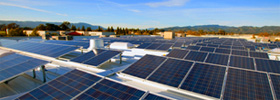 
|
|
|
|

News & ViewsReturn To Main →
GENERAL ENQUIRIES:
ABOUT PHOTOVOLTAICS:
PV AND YOU:
ANSWERS: GENERAL ENQUIRIES Q:How does sunlight affect life on Earth? A: The energy from the Sun is critical to all life on Earth. Evolutionary scientists have shown that the Sun's energy played an essential role in 'spontaneous generation', whereby the very first single-cell amoebae split and developed into more complex lifeforms. Plants require sunlight for the process of photosynthesis or the production of sugars, and a by-product of the photosynthetic process is cellular respiration, which releases the oxygen that we must have to stay alive. All types of animals, including humans, also rely on the Sun's heat to maintain body temperatures and sustain life. Thankfully, the Sun has sufficient helium mass to provide the Earth with energy for another 5 billion years. Back To Top Q:How do we get electricity from the sun? A: Sunlight is made up of small particles of energy called photons. Photovoltaic (PV) systems use semi-conducting materials such as silicon to absorb some of these photons and transfer them to electrons. This process is known as the photoelectric effect and it is the basic physical process by which PV cells convert sunlight to electricity. Special electrical properties of the Photovoltaic cell provide the voltage needed to drive the current through an external load (such as a light bulb). Back To Top Q:What does energy conversion efficiency mean? A: Energy conversion efficiency is an expression of the amount of energy produced in proportion to the amount of energy consumed, or available to a device. The Sun produces a lot of energy in a wide light spectrum, but we have so far learned to capture only small portions of that spectrum for conversion to electricity using photovoltaics. Today's commercial PV systems are about 7% to 17% efficient. By comparison, a typical fossil fuel generator has an efficiency of about 28%. However, some experimental PV cells now convert nearly 40% of the energy in sunlight to electricity. Back To Top ABOUT PHOTOVOLTAICS Q:What does photovoltaic (PV) mean? A: The word 'photovoltaic' essentially means electricity from the energy of sunlight. First used in about 1890, the word has two parts: photo, derived from the Greek 'phos' meaning light, and volt, a unit of measurement named for Alessandro Volta (1745-1827), a pioneer in the study of electricity. Back To Top Q:How does PV differ from other solar energy technologies? A: There are four main types of solar energy technologies: Photovoltaic (PV) systems, which convert sunlight directly to electricity by means of PV cells made of semiconductor materials. Concentrating solar power (CSP) systems, which concentrate the sun's energy using reflective devices such as troughs or mirror panels to produce heat that is then used to generate electricity. Solar water heating systems, which contain a solar collector that faces the sun and either heats water directly or heats a 'working fluid' that, in turn, is used to heat water. Transpired solar collectors, or 'solar walls', which use solar energy to preheat ventilation air for a building. Back To Top Q:What are the components of a PV system? A: A PV system is made up of several different components. These include groups of PV cells called 'modules' (also known as 'panels'); one or more batteries; a charge regulator or controller for a stand-alone system; an inverter for a utility-grid-connected system or when alternating current (AC) rather than direct current (DC) is required; wiring; and mounting hardware or a framework. Back To Top Q:How long do PV systems last? A: A PV system that is well designed, installed and maintained can operate for more than 20 years. The basic PV module has no moving parts and can last more than 30 years. The best way to ensure and extend the life and effectiveness of your PV system is by having it properly installed and well maintained. Back To Top Q:Where are PV systems being used? A: PV systems are generating clean power in a whole host of applications right across the world - from urban skyscrapers to remote villages in developing countries. PV electricity can be used to power all manner of household appliances, computing and communications equipment, water pumping and lighting. Cost-effective examples of lighting powered by PV include small garden lights, street lights, lighting for recreational areas, highway signs, warning signs and signals, and lighting for businesses and homes. Virtually any power need can be met with PV. Back To Top Q:When will PV systems replace coal and nuclear power plants? A: A major driver in the deployment of solar systems is public demand for clean energy. Fossil-based energy pollutes the environment, and nuclear energy creates hazardous waste. If we stop to consider the environmental and health costs of fossil-fuel and nuclear energy, then solar energy makes sense. So, in the coming decades, we will begin to see many more solar energy systems being built in areas that now use fossil fuels and nuclear energy for electricity generation. In developing countries, where there is little or no supply system for conventional energy, solar energy is already being used because it is much less expensive than many other options, and the environmental benefits associated with this cleaner form of energy are significant. Back To Top Q:How much space would be needed for PV systems to meet the entire world's electricity needs? A: Contrary to some popular notions, the landscape of a world relying on PV would be almost indistinguishable from the landscape we know today. There are three reasons for this. First, PV systems have siting advantages over other technologies. They can be put on roofs and can even be an integral part of a building, such as a skylight. Second, even ground-mounted PV collectors are efficient from the perspective of land use. Flat-plate PV technology is the most land-efficient means to produce renewable energy. Third, adequate sunlight is ubiquitous and often abundant, and present in predictable amounts almost everywhere. For example, in the United States, cities and residences cover about 140 million acres of land. The nation's energy requirements could be met simply by applying PV to 7% of this area - on roofs, on parking lots, along highway walls, on the sides of buildings, and in other dual-use scenarios. Not one single acre of new land would need to be appropriated to make PV the primary energy source. Back To Top PV AND YOU Q:Why should I use PV-generated electricity? A: For a growing number of users, particularly those who are environmentally aware, PV is the clear choice. PV provides sustainable energy, operates silently, produces no toxic emissions or greenhouse gases, and causes no hazardous waste. PV systems generate electricity using the Sun's free energy, so the ongoing costs are minimal. Moreover, continued R&D means installation costs are gradually being reduced. Some people would rather invest capital on an energy-producing improvement to their property than continually send money to a power company. Others like the security of reducing the amount of electricity they buy from power utilities, because it makes them less vulnerable to power outages and future increases in the price of electricity. Back To Top Q:Can I use PV to power my home? A: PV can be used to power your entire home's electrical systems, including lights, cooling systems, and appliances. PV systems today can be blended easily into both traditional and non-traditional homes. The most common practice is to mount modules onto a south-facing roof or wall. For an additional aesthetic appeal, some modules resemble traditional roof shingles or can be built right into glass skylights and walls. Back To Top Q:Can I use PV to power my business? A: PV systems can be blended into virtually every conceivable structure for commercial buildings. You will find PV being used outdoors for security lighting as well as in structures that serve as covers for parking lots and bus shelters, generating power at the same time. Architects can use building-integrated PV to design buildings that are environmentally responsive, aesthetically pleasing, and produce their own power. Building-integrated PV provides a dual-use building material, reduces PV system costs by using the building as the mounting or support structure, and reduces utility bills through on-site power production. Back To Top Q:How much can I save by using a PV system? A: A 10% efficient PV system will generate up to 180 kilowatt-hours per square meter. A PV system rated at 1 kilowatt will produce up to 1800 kilowatt-hours a year. Allowing for a loss of efficiency of less than 1% per annum, such a PV system could generate close to 36,000 kilowatt-hours of electricity over 20 years and close to 54,000 kilowatt-hours over 30 years. This means that a 1Kw PV system generates more than US$10,000 worth of electricity over 30 years. In many countries, preferential rates are paid for solar-generated electricity and various other grants and tax incentives are available that improve the economics of PV. Back To Top Q:How do I know if I have enough sunlight for PV? A: A PV system needs unobstructed access to the sun's rays for most or all of the day. Climate is not really a concern because PV systems are relatively unaffected by severe weather. In fact, some PV modules actually work better in colder weather. There is enough sunlight to make solar energy systems useful and effective almost anywhere in the world. Most homes have adequate roof space for a PV system, and this can be complemented by integrating the system into walls or by using modules to cover a porch or patio in the backyard. Back To Top Q:How big a PV system do I need? A: The size of solar system you need depends on several factors-such as how much electricity or hot water or space heat you use, how much sunshine is available where you are, the size of your roof, and how much you're willing to invest. A PV system does not necessarily have to cover 100% of your energy needs. In most cases a PV system is connected to the grid so that the solar electricity generated is sold to the utility company and you continue to buy electricity as normal. Back To Top Q:Are there disadvantages to using solar energy? A: Solar energy technologies often have a higher initial cost outlay. This means that a person is likely to pay more money up front to purchase and install a solar system. Still, in nearly all cases, the high initial cost is recovered through substantial fuel savings over the life of the product (15-30 years). Back To Top Q:When will I be able to buy a solar electric or PV-powered car? A: The benefits of solar cars are obvious - they don't pollute, and free sunlight is their fuel. The drawbacks are that, using today's technology, a solar car has to be very lightweight for the panels to provide enough energy to power the car at road speeds, and it has to have enough battery storage to travel long distances without sunlight (at night and on overcast days). As part of continued research and development, many organizations are improving the systems used in solar cars to make them more efficient and cost effective. Some car companies are making great strides in this area with the new petrol/electric hybrids, and future progress is likely to be rapid. Back To Top
Source Acknowledgement:
Shamrock Renewable Group acknowledges information provided by the U.S. Department of Energy (www.eere.energy.gov) as source material for this section of the website. |

|

 
Shamrock Renewable Energy Services, Inc.
Bishop Ranch 3 2603 Camino Ramon, Suite 200 San Ramon, CA 94583
925.242.2037 (Tel)
info@shamrockrenewable.com
925.648.9673 (Fax) |
Website Design By KYLECREATIONS
© 2012-13 Shamrock Renewable Energy Services, Inc. All rights reserved. |














